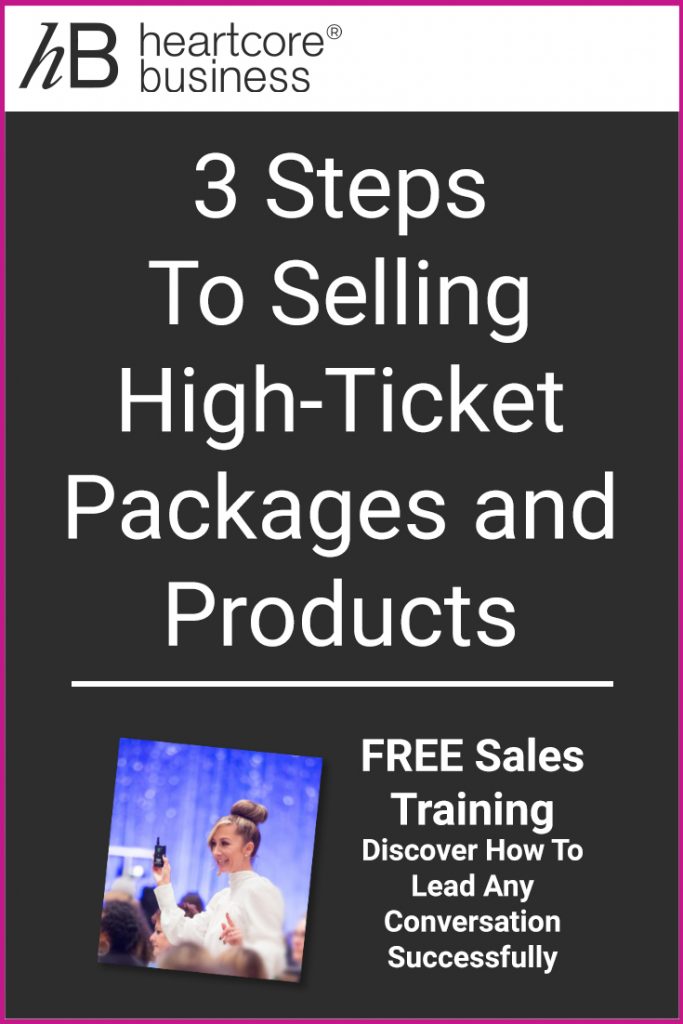One of the very best ways to make more money in your business is to sell high-ticket packages, products, and services.
But if you’re hearing, “No,” more than, “Yes,” you might be feeling a bit discouraged. The good news is that you can increase your conversion rate and sell those high-ticket items—when you know this powerful three-step process for selling more.
First of all, don’t expect people to say, “Yes,” right away. Be prepared to follow up and meet a prospect where he is. Just like any relationship, sales is all about give and take.
The reality is that the majority of people don’t say, “Yes.” Not to you, not to me, not to anyone. (And if the majority of people do say, “yes” to you, then you need to charge more!)
But you can get to, “Yes,” more often, using this three-part strategy:
#1 Connection is currency.
Actually, to be more specific, consistent connection is currency.
When you’re building your email list, or your community, it’s important to be consistent and generous as you communicate with them. For example, you may send emails at the same time each day or each week.
The mind loves familiarity! This is why it’s so hard to break out of our comfort zones—and it’s also why your audience will begin to trust you if you’re consistent with your communication.
A quick note on what to consider if people say, “Yes” the majority of the time:
If people say, “Yes,” right away, then it’s probably because they’re already primed to work with you. They’ve been part of your world for a while, whether it’s because they’re on your email list or they follow you on social media. They’ve already made the internal decision to work with you, based on something you said or some piece of advice you offered.
The more you do online or via email, the greater number of opportunities you’re creating to connect with people. You’re increasing your influence, and more importantly, people are resonating with the information you’re putting out.
Again, consistency and generosity pay off in terms of putting yourself out there. No, you don’t have to be on every single platform, but if you choose your favorite platforms and be consistent on them, you’ll begin building a foundation of people who relate to you and what you’re putting out. And they’ll be primed to say, “Yes” when you make your offers.
#2 Follow up!
When you first hear the phrase, “Follow up,” you may feel a little “icky,” as if you’re trying to track down someone who doesn’t actually want to buy from you, or like you’re being a sleazy salesperson.
What if you reframed that?
Follow-up is like standing for people. It’s opening up the space for them to make the transformation your service of product will potentially provide. You’re encouraging your prospect to believe in himself!
Every time you follow-up, make sure you do so in a positive way: Connect with the prospect, and make sure he feels like you’re giving him something of value.
During follow-up, don’t take objections as personal rejections.
When you make an offer, you’re likely to hear one of several common objections: “I need to think about it,” or, “I need to ask my husband or wife or partner,” or, “I can’t afford it,” or, “I’m not ready.” You may hear a straight, “No,” or, “Not yet.”
Don’t take these answers as if they’re personal rejections; they aren’t.
First of all, some prospects have to finish going through their own processes.
Secondly, it’s possible that you didn’t form a strong enough connection with that prospect, and he needs more giving from you.
If that’s the case—you need to strengthen your connection—then follow up with something designed to help the prospect believe in himself enough to make the investment in himself.
You don’t even have to mention the offer, product, or service.
Maybe you send him an inspirational video or a message asking him about his dream. Help him believe that dream is possible.
After three or four connection points, bring the offer back in—positioned as a solution.
Be careful: don’t push the offer. When you push, and you then get a prospect to give in and say, “Yes” to an offer, that’s the person who will disappear because he doesn’t want to be pushed any more.
Instead, evoke—help people believe in themselves.
#3 Talk Only About What People Want.
Sales is service. It’s all about give and take.
Find out what’s important to your prospect, and define where that desire meets up with what’s important to you (which is making the sale so you can help him experience the transformation he’s seeking, right?).
Far too often, we talk with someone from the place where our own vision lives. When you’re having an enrollment conversation with someone, talk about what’s important to him.
In conclusion …
The basics of sales never change. Sales is service: it’s about defining what someone wants or needs, and then showing your prospect how you can help him get what he wants or needs.
When you implement this three-part strategy, you’ll see an increase in your conversion rate and you’ll earn more money!


